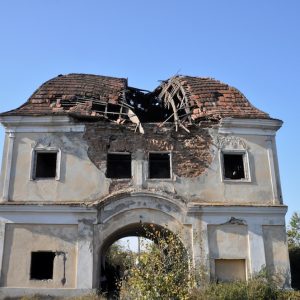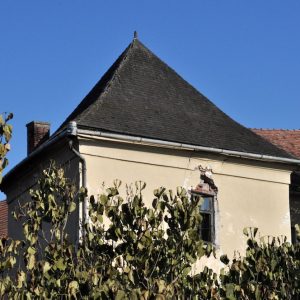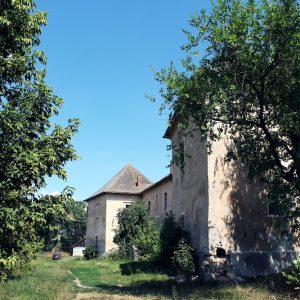- National Monument Number:
- MS-II-m-A-15705
- Address:
- Iernut, Tudor Vladimirescu street, nr. 4
- Dated to:
- Ownership:
- The Catholic Church
After the Battle of Sânpaul in 1575, István Báthory, prince of Transylvania defeated the nobles fighting along Gáspár Bekes, executed Gáspár Bogáthy and the town of Iernut was confiscated for the treasury of Transylvania. In 1587 the castle was donated by Zsigmond Báthory to Ferenc Kendi, but after two years he was executed too. The new owner of the castle, Boldizsár Kornis was also executed in 1610, but the building remained the property of the Kornis family. After another confiscation, Gábor Bethlen, prince of Transylvania also initiated a series of transformations on the building.
The castle was bought in 1649 by György Rákóczi II, prince of Transylvania, he rebuilt the castle after the plans of the Venetian architect, Agostino Serena. This building phase was commemorated by the inscription on the northern gate: “AUGUSTINUS SERENA ARCHITECTUS VENETUS OPERA FECIT”. After the lost battle of Florești against the Ottomans the castle became the property of the new princess, Anna Bornemissza. The castle was then inherited by his son Mihály Apafi II, then by his widow, Kata Bethlen. During the rule of the prince of Transylvania, Mihály Apafi II, 15 diets of the Transylvanian nobility took place here. The castle was taken from the Habsburgs by Rákóczi's Kuruc troops in 1703. Ferenc Rákóczi II stopped here in 1707, on his way to Târgu Mureş, where he was to be crowned Prince of Transylvania. After the death of the princess, in 1758, the castle became the property of the treasury. In 1764 the building was bought by chancellor Miklós Bethlen from the treasury. In 1802 the castle's shingled roof burned down due to an unintentional firearm shooting of a bailiff. The damaged roof was replaced with a smaller, more simple roof. The castle's new gate building, the Snake House was built in the second half of the 18th century, with snake decorations - motif taken from the escutcheon of the Bethlen family. Until 1885 the castle belonged to the Bethlen family, when Márk Bethlen lost the castle to Count Jenő Haller during a card game. The winner donated the estate to the Roman-Catholic Church of Transylvania. The Roman-Catholic Status of Transylvania bought the estate in 1887 and renovated it partly. They demolished the corrals and (they also) filled the moat with soil. At that time the castle was the property of the Roman-Catholic Church of Alba-Iulia. The estate was nationalized in 1948, and was transformed it into a model farm and an agricultural school during the 1990’s. The separate gate building, the Snake House, was restored in the first half of the 1960’s and became a memorial house.
Today the castle is in a ruinous condition: its walls and roof are falling down. On 18th March 2012 the roof of the bastion burned down.













